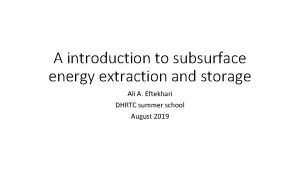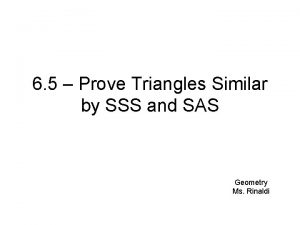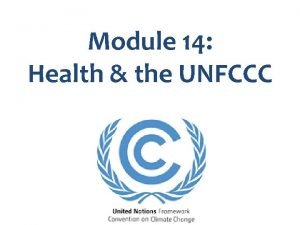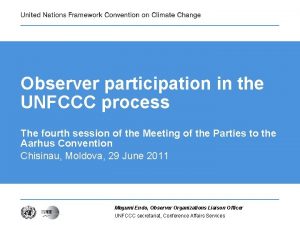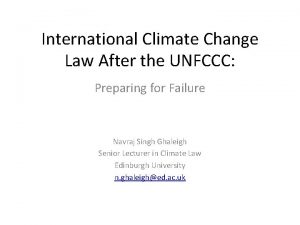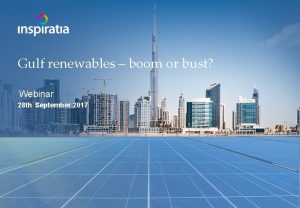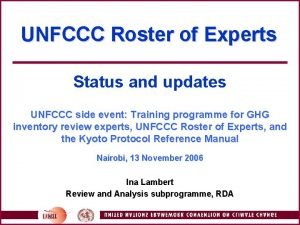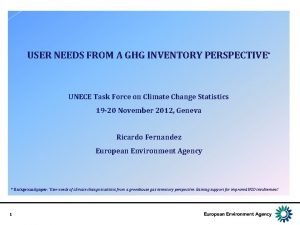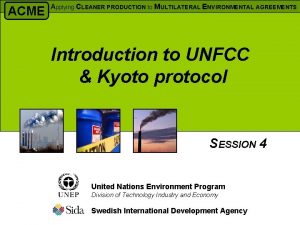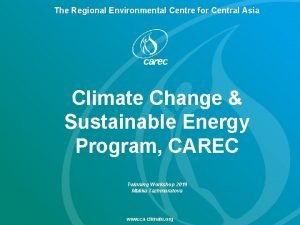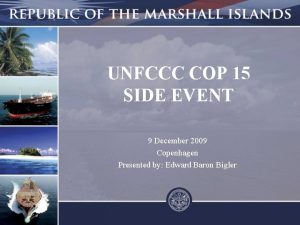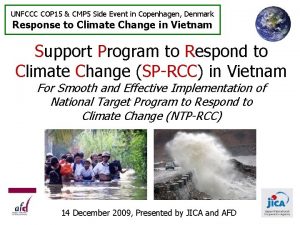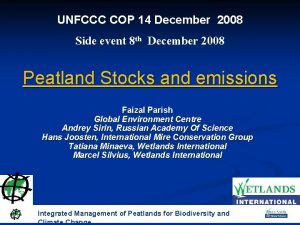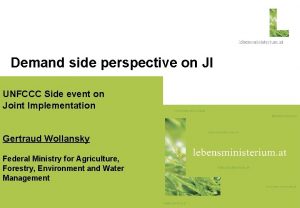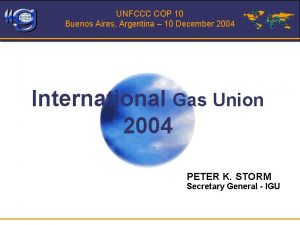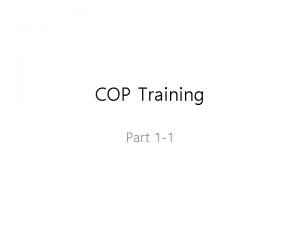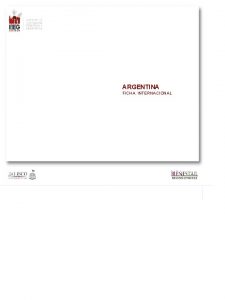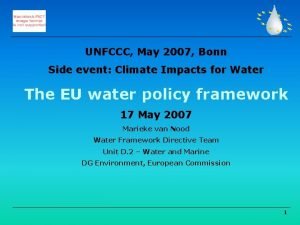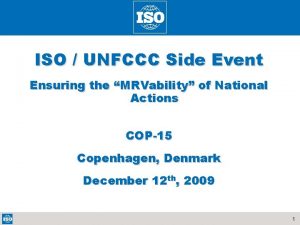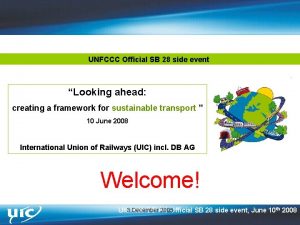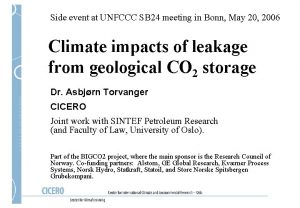COP 10 of the UNFCCC Argentina Side event

















- Slides: 17

COP 10 of the UNFCCC_ Argentina Side event on the presentation of new national communications from non-Annex I 13 th December 2004. Presentation of the Sudan's First National Communications (SFNC) By: Nagmeldin Elhassan

Sudan and Climate Change l l l Signed the UNFCCC in Rio 1992 and ratified in November 1993 Active member, attending all sessions and participation in many UNFCCC activities First National Communications prepared and Submitted in June 2003 Active member of the IPCC, a number of experts selected as lead authors in different publications October 2004 the instrument to ratify the Kyoto Protocol has been signed by the president

The climate change enabling project l l l Funded by GEF and UNDP(400, 000 USD) with inkind contribution from Sudan’s government Implemented by Higher Council for Environment and Natural Resources (HCENR) and UNDP Technical supported by Stockholm Environment Institute Boston Center (SEI_B) Implementation started in 1998 and completed by the end of 2001 Sudan’s First National Communications prepared and submitted, June 2003.


The objectives : l Main: l l To foster human resource development in order to effectively deal with climate change and address its global and nationwide consequences and implications Immediate: l l l To improve Sudanese capacity to comply with UNFCCC To facilitate the development of approaches that integrate national sustainable development objectives with responses to the UNFCCC; and To prepare and institutionalize the national communication

Sudan’s V&A assessment - Rationale l Sudan is particularly concerned with impacts of climate change: l l l the majority of its land is quite sensitive to changes in temperature and precipitation. fragile ecosystems weak infrastructure and economy. food security is mainly determined by rainfall more than 70% of Sudan population is directly dependant on climate-sensitive resources for their livelihood.

Sudan’s V&A assessment - Approach l Study area: Kordofan region: l l l North and longitudes 27 to 32 East Exposure units: l l Located in central Sudan between latitudes 9 30’ and 16 24’ Agricultural (rainfed) sector: Sorghum, millet and Gum Arabic Water sector: surface water Human health sector: malaria Methods and approaches: l IPCC, UNEP, USCSP etc, material used l Climate scenario: GCMs data, (Magicc/Scengen v. 2. 4). l Impacts models (water balance, FAO, MIASMA. . etc) Conducted by the V&A team which consist of experts from national institutions involved in these sectors

Sudan’s V&A assessment - Results The next 30 – 60 years: l Agriculture and forestry: l l l Water sector: l l Shift in the agro ecological zones southward Shrinking in current crop production areas. Crop yield decline in selected stations by 29% - 71% for Sorghum (more affected than millet) and 5% - 62% for Millet Gum Arabic yields predicted to decline between 25% and 30% region-wide. Greater water deficit is expected in years 2030 and 2060 than in the baseline, due to a decline in projected rainfall and an increase in the PETs from temperature rise. Human health (Malaria): l l Increased Transmission Potential (TP) of malaria in 2030 and 2060, particularly in winter due to higher temperatures. Greater risk of outbreak between October-December Less number of cases between April-July due to increase in temperature beyond the maximum tolerance limits of malaria parasites Climate change may alter the current distributions and intensity of malaria in Sudan.

Sudan’s V&A assessment - Limitations l l Limited expertise in modeling, long-term projections, suitability and applicability of models used for climate scenarios and impact models used Data gaps: incomplete (meteorological data, crop productions, disease incidences), not v. relaible, not easily accessible and poorly kept Future socio-economic changes and their effects on the exposure are not well taken into account due to the lack of relevant expertise and methodological constraints. Adaptation measures not well defined and assessed due to lack of relevant expertise, methodological constraints, time and resources.

Sudan’s GHG Inventory l l l l Sectors covered: Energy, Industrial processes, Agriculture, LUCF and waste. Gases include CO 2, CH 4, N 2 O, NOx, CO, HFCs and NMVOC Method: Revised 1996 IPCC GL and IPCC Beta v 1. 0 software used The data covered 5 years (1993 -1997), with 1995 selected as the base year for all sectors. Conducted by the GHG inventory team consist of experts from national institutions involved in these sectors Total emissions is 25, 752 Gg, of which 75% is CO 2 mainly emitted by LUCF (75%) and energy (22%) sectors Uncertainty due to data problem, methodological problems technical capacity problems

Table 2. 8: Greenhouse gas emissions, 1995 (Gg) GHG Source & Sink Categories Total CO 2 equiv HFCs Net CO 2 Emitted Energy (sectoral approach 16, 706 4, 328 CH 4 (22%) 150 173 0 0 1, 713 (75%) N 2 O 1 NOx CO NMVOC SO 4 P A 58 2, 104 263 1 - - 0 0 11 0 2 3 30 16 388 0 0 - - 90 1 22 787 0 0 - - Industrial Processes 173 Agriculture 50, 083 Land-use change & Forestry 21, 184 Waste 1, 055 0 33 1 0 0 - - 89, 220 20, 077 1, 985 33 97 3, 280 274 1 2 3 Total National Emission and Removals 15, 577

Sudan’s Mitigation Analysis l l l The GHG mitigation analysis focused on options that serve both national development priorities and response to the UNFCCC Mainly energy and the LUCF (forestry and rangeland) sectors were covered Models: LEAP, COMAP Conducted by the Mitigation team, experts from national institutions involved in these sectors Limitations: Data issues (availability, accessibility, and reliability) and Technical and institutional capacities

Towards a National Implementation Strategy Overall objective: To promote sustainable development paths that improve Sudan's adaptive capacity and limit its growth in GHG emissions through integration of climate change issues and concerns into national policies, strategies and development plans. l

Towards a National Implementation Strategy l Specific objectives include: l l To improve scientific knowledge and understanding of climate change and its potential consequences on Sudan, To build an enabling environment to integrate climate change issues and concerns into national development (capacity building, institutional infrastructure), l l To raise stakeholders awareness, To identify and build synergies with other conventions and agreements (coordination), To develop a national adaptation programme. To develop a national GHG mitigation programme.

Who participated in the process l l l About 50 institutions including government, the research and academia and the civil society organizations participated in the process More than 200 experts participated in the scientific studies, the preparation and review of the SFNC A national climate change committee established 3 national teams of experts established on GHG inventory, Mitigation analysis and V&A assessment Focal units is being established within relevant institutions to handle climate change issues

What is achieved l l l A national climate change process has been established with active participation from all relevant stakeholders Awareness has been created within the participating institutions also among the public through media and public events Technical capacities is being built within relevant institutions to deal with climate change issues, Very useful partnership created with SEI_B; and Cooperation and communication links established with other international institutions and parties

Suggestions on how to improve the process l • • • Capacity building with regard to the following: - Data management techniques - Development and use of socio-economic scenarios - Development of climate scenarios ( selection and downscaling of GCMs) - Use of impact models in V&A assessment - Modeling and long-term projection techniques - Uncertainty management in GHG inventory Provision of technical backstopping and material (e. g. models and training packages). Establishment of joint regional programs and projects (e. g. GHG inventory database, impact assessment) Provisions of adequate financial resources
 Cop 1 cop 2
Cop 1 cop 2 Good cop bad cop interrogation
Good cop bad cop interrogation Sss similarity theorem examples
Sss similarity theorem examples Angle angle similarity postulate
Angle angle similarity postulate Ways to prove triangles similar
Ways to prove triangles similar Similar font
Similar font Unfccc
Unfccc Megumi endo unfccc
Megumi endo unfccc Unfccc
Unfccc Unfccc 2020
Unfccc 2020 Unfccc roster of experts
Unfccc roster of experts Unece nuclear energy
Unece nuclear energy Unfccc annex 1 countries
Unfccc annex 1 countries Unfccc 2020
Unfccc 2020 Platzbedarf side by side melkstand
Platzbedarf side by side melkstand Sell side vs buy side
Sell side vs buy side Condylar angle
Condylar angle Square groove weld
Square groove weld
